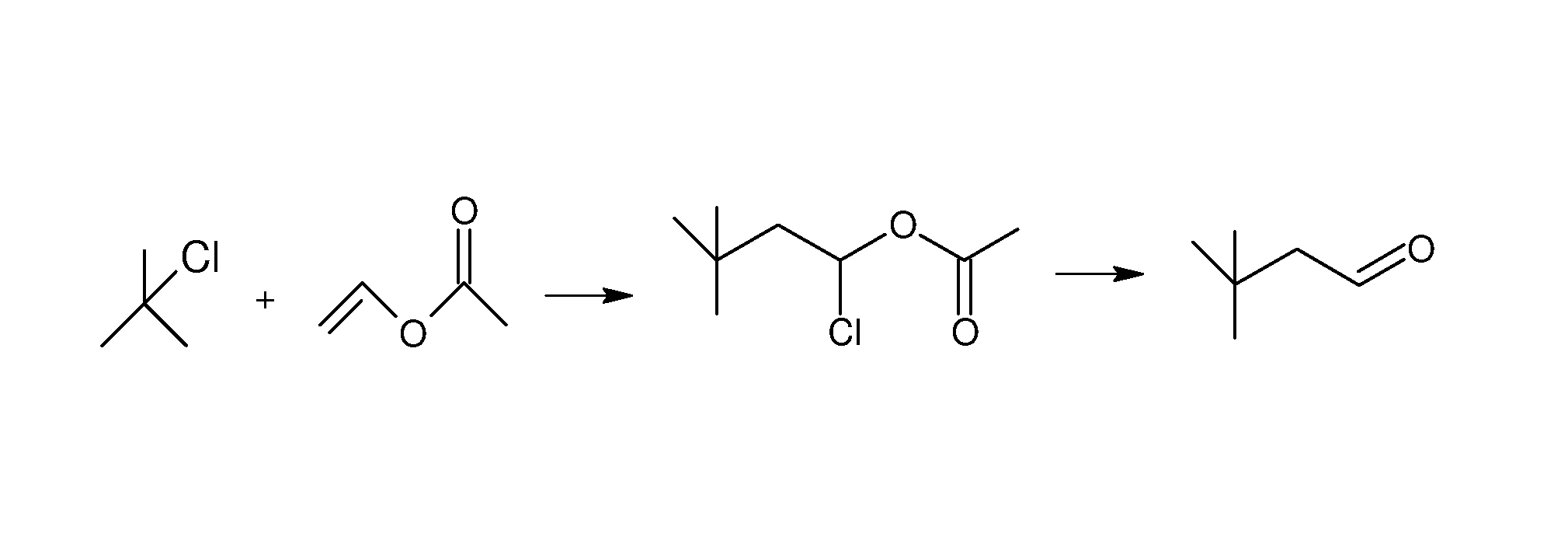Method for preparing 3,3-dimethylbutyraldehyde
a technology of dimethylbutyraldehyde and dimethylbutyraldehyde, which is applied in the preparation of carbonyl compounds, organic chemistry, chemistry apparatus and processes, etc., can solve the problems of high transportation, storage, and transportation requirements, and achieves low price of products, short procedure, and high safety in transportation and storage.
- Summary
- Abstract
- Description
- Claims
- Application Information
AI Technical Summary
Benefits of technology
Problems solved by technology
Method used
Image
Examples
example 1
[0021]A method for preparing 3,3-dimethylbutyraldehyde is conducted as follows:
[0022]1) 50 kg of dichloromethane is added to a 100 L enamel reactor, stirred and cooled to a temperature of between −7° C. and 2° C. 1.3 kg of aluminum trichloride is added, 20 kg of t-butyl chloride is dropped within 3 hr, and 18.6 kg of vinyl acetate is dropped within 2 hr to yield a mixture. The mixture is allowed to react at a temperature of between −2° C. and 0° C. for 2 hr.
[0023]After the reaction, 14 kg of deionized water is added to the reactor and stirred completely. An organic phase is separated and washed using 6.7 kg of a 5% sodium carbonate solution until a PH value reaches between 8 and 9. The dichloromethane organic phase is collected and added with 5 kg of anhydrous sodium sulfate for desiccation. Dichloromethane is condensed and recovered at a temperature of between 30° C. and 50° C. and the organic phase is distilled under vacuum, a first fraction is collected at 60-64° C. / 20 mmHg 35.7 ...
example 2
[0025]A method for preparing 3,3-dimethylbutyraldehyde is conducted as follows:
[0026]1) 225 kg of dichloromethane is added to a 500 L enamel reactor, stirred and cooled to a temperature of between -7° C. and 2° C.9 kg of p-toluene sulphonic acid is added, 80 kg of t-butyl chloride is dropped within 2 hr, and 70 kg of vinyl acetate is dropped within 2 hr to yield a mixture. The mixture is allowed to react at a temperature of between −2° C. and 0° C. for 2 hr.
[0027]After the reaction, 56 kg of deionized water is added to the reactor and stirred completely. An organic phase is separated and washed using 25 kg of a 5% sodium carbonate solution until a PH value reaches between 8 and 9.The dichloromethane organic phase is collected and added with 15 kg of anhydrous sodium sulfate for desiccation. Dichloromethane is condensed and recovered at a temperature of between 30° C. and 50° C. and the organic phase is distilled under vacuum, a first fraction is collected at 60-64° C. / 20 mmHg 131.7 ...
example 3
[0029]A method for preparing 3,3-dimethylbutyraldehyde is conducted as follows:
[0030]1) 1200 kg of dichloromethane is added to a 3000 L enamel reactor, stirred and cooled to a temperature of between −7° C. and 2° C. 55 kg of iron trichloride is added, 480 kg of t-butyl chloride is dropped within 2 hr, and 405.7 kg of vinyl acetate is dropped within 2 hr to yield a mixture. The mixture is allowed to react at a temperature of between −2° C. and 0° C. for 2 hr.
[0031]After the reaction, 320 kg of deionized water is added to the reactor and stirred completely. An organic phase is separated and washed using 160 kg of a 5% sodium carbonate solution until a PH value reaches between 8 and 9. The dichloromethane organic phase is collected and added with 100 kg of anhydrous sodium sulfate for desiccation. Dichloromethane is condensed and recovered at a temperature of between 30° C. and 50° C. and the organic phase is distilled under vacuum, a first fraction is collected at 60-64° C. / 20 mmHg 77...
PUM
| Property | Measurement | Unit |
|---|---|---|
| Temperature | aaaaa | aaaaa |
| Temperature | aaaaa | aaaaa |
| Temperature | aaaaa | aaaaa |
Abstract
Description
Claims
Application Information
 Login to View More
Login to View More - R&D
- Intellectual Property
- Life Sciences
- Materials
- Tech Scout
- Unparalleled Data Quality
- Higher Quality Content
- 60% Fewer Hallucinations
Browse by: Latest US Patents, China's latest patents, Technical Efficacy Thesaurus, Application Domain, Technology Topic, Popular Technical Reports.
© 2025 PatSnap. All rights reserved.Legal|Privacy policy|Modern Slavery Act Transparency Statement|Sitemap|About US| Contact US: help@patsnap.com


